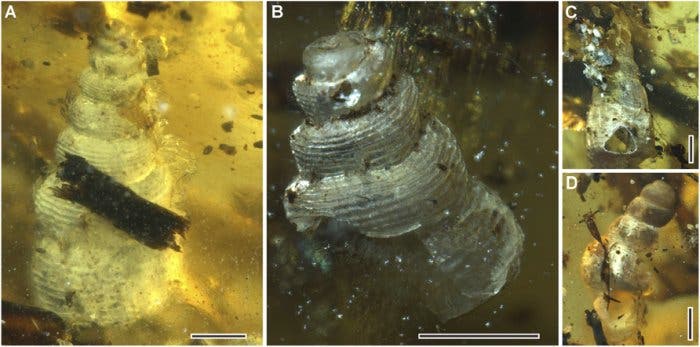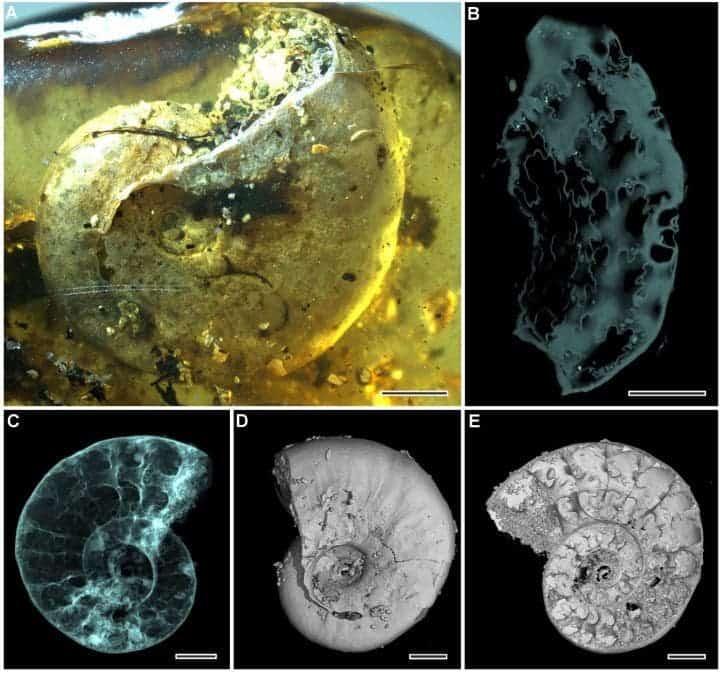You’ve seen insects, plants, and even small birds trapped in amber — but have you ever seen sea creatures?

The vast majority of creatures discovered in amber live in forests, and there’s a very good reason for that: amber is fossilized tree resin, and trees usually live, well, in forests. However, researchers working in Myanmar have found something completely unexpected: sea creatures and land dwellers, side by side, trapped in one of the most amazing pieces of amber you’ll ever see.
The 99-million-year-old amber from Northern Myanmar hosts a diverse assemblage of creatures — over 40 in total. The creatures include four sea snails, several isopods, 22 mites, a spider, beetles, flies, cockroaches, and several other yet-unidentified creatures. The highlight of the piece, however, is an ammonite: an extinct, exclusively marine creature.
Researchers are at a loss as to how all these creatures wound up together and got trapped in tree resin.
“It is rare to find aquatic organisms in amber, and it is extremely rare to find marine organisms in amber, let alone macroscopic marine organisms mixed with intertidal, terrestrial, and potentially freshwater aquatic organisms,” the researchers wrote in their paper.
There are some reliable assumptions to be made, however. Since the piece contains both aquatic and terrestrial creatures, particularly creatures that lived on the forest floor, it is believed that the amber formed in a coastal forest. Perhaps there was a flood or some other event that moved the ammonite and other marine creatures towards the tree, where they were engulfed in resin.

All the shells from marine creatures are empty, so the organisms were long dead by the time they were engulfed; the outer shell of the ammonite is broken away and the entrance of the shell is full of sand. The amber also contains additional sand.
“There is a diverse assemblage (at least 40 individuals) of arthropods in this amber sample from both terrestrial and marine habitats, including Isopoda, Acari (mites), Araneae (spiders), Diplopoda (millipedes), and representatives of the insect orders Blattodea (cockroaches), Coleoptera (beetles), Diptera (true flies), and Hymenoptera (wasps). The incomplete preservation and lack of soft body of the ammonite and marine gastropods suggest that they were dead and underwent abrasion on the seashore before entombment,” researchers write.
The most plausible scenario is that the resin-producing tree lay on or right next to a sandy beach. The flying insects were trapped in amber while it was still on the tree, flying too close and getting stuck. As the resin slowly flowed down the tree trunk, it trapped more and more organisms. As it reached the floor, it finally encased some unfortunate marine creatures that were washed ashore.

“The shells may record an exceptionally high, perhaps storm-generated tide, or even a tsunami or other high-energy event. Alternatively, and more likely, the resin fell to the beach from coastal trees, picking up terrestrial arthropods and beach shells and, exceptionally, surviving the high-energy beach environment to be preserved as amber,” researchers write.
At any rate, it was a spectacular chain of events that culminated with just the right conditions to preserve this stunning piece of amber for about a hundred million years.
It’s not exactly clear how old the piece of amber is. Researchers suspect it is 99 million years old since that is the date of the layer it was found in, but it could be even older.

The team also used X-ray micro-computed tomography (micro-CT) to obtain high-resolution three-dimensional images of the ammonite including its convoluted shell sutures, which are very important for determining the species of ammonite.
The study “An ammonite trapped in Burmese amber” was published in Proceedings of the National Academy of Sciences


